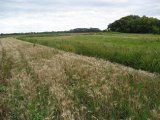EPA Research in North Dakota

EPA researchers are working hard to protect communities across the nation. Learn about some of the work EPA researchers are doing in North Dakota.
For more EPA work, see EPA in North Dakota.
Simulating Herbicide Drift on Native Prairie Plants
EPA researchers conducted a study to explore the potential impacts that herbicides might have on native plants important to North Dakota prairie habitats. The research was part of a series of regional analyses to evaluate the potential drift of herbicides to non-target plants in different parts of the country. Read about the study, Effects of Simulated Glyphosate Drift to Native Prairie Plants and Canola-Compatible Brassicaceae Species of North Dakota, United States in EPA’s Science Inventory.
Satellite Derived Measures of Cyanobacteria
Cyanobacteria blooms are an environmental and human health problem across the US. They are capable of producing toxins, odors, and surface scum that threaten the health of humans and animals, the quality of drinking water supplies, and the ecosystems in which they develop. EPA developed the CyAN app and CyANWeb, easy-to-use and customizable applications that provide access to algal bloom satellite data for over 2,000 of the largest lakes and reservoirs across the US. States with lakes, like North Dakota, can use CyAN to make faster and better-informed management decisions related to cyanobacterial blooms.
